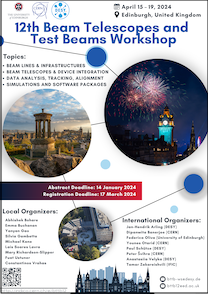The Alpha Magnetic Spectrometer (AMS) is a space-borne experiment with the unique capability of distinguishing matter from anti-matter, thanks to its capability of measuring the charge sign from the track deflection within its magnetic field. The AMS Collaboration decided to upgrade the silicon tracker with the installation of an additional tracking layer on the top of the existing instrument....
The High-energy Proton Experiment Station (HPES) is currently being constructed as part of the CSNS-II project. The 1.6 GeV protons are extracted from the Rapid Cycling Synchrotron of CSNS and directed to the HPES in the form of "single particle beam". Test terminals have been designed within the HPES to facilitate the completion of beam tests. The primary objective of the HPES test terminals...
A new hybrid photodetector, based on a vacuum tube containing a transmission photocatode, a microchannel plate and a CMOS pixelated read-out anode (the Timepix4 ASIC) is under development in the framework of the 4DPHOTON ERC-funded project.
This detector will allow to image single photons up to a maximum rate of 1 billion photons per second over an area of $\sim$7 cm$^2$, reaching...
Caribou is a versatile data acquisition system used in multiple collaborative frameworks (CERN EP R&D, DRD3, AIDAinnova) for both bench-top and test-beam qualification of novel silicon pixel detector prototypes. The system is built around a common hardware, firmware and software base shared accross different projects, thereby drastically reducing the development effort and cost. The current...
Central to particle physics experiments using high intensity beams is event selection to allow DAQ systems to cope with high data rates. This is true for the MUonE experiment, both for its final configuration and upcoming test beams. Online track-fitting for event selection will be implemented directly on FPGAs, using High-Level Synthesis to convert C++ code into an HDL description to then run...
Modern pixel detectors are being built to withstand the ever higher collision rates and pile-up of colliders designed to push luminosity and intensity limits. The ITk is a new silicon tracker for the ATLAS experiment designed to increase detector resolution, readout capacity, and radiation hardness, and the five innermost layers will be built of hybrid pixel modules. The material budget of the...
Monolithic active pixel sensors (MAPS) manufactured in a 65 nm CMOS imaging process are attractive candidates for tracking charged particles at future lepton and electron-ion colliders, as well as for beam telescopes. To investigate this technology and explore the design challenges of porting a hybrid pixel detector architecture into a monolithic chip, the H2M (Hybrid-to-Monolithic) test chip...
In order to cope with the occupancy and radiation doses expected at the High-Luminosity LHC, the ATLAS experiment will replace its Inner Detector with an all-silicon Inner Tracker (ITk), containing pixel and strip subsystems. The strip subsystem will be built from modules, consisting of one or two n+-in-p silicon sensors, one or two PCB hybrids containing the front-end electronics, and one...
The Water Cherenkov Test Experiment (WCTE) will be installed in CERN's recently upgraded T9 “Test Beam” Area in Summer 2024. The upgrade to the East Area, completed in 2022, allows the T9 beamline to reach lower beam momenta than previously possible, now down to ~100MeV/c. The WCTE has three goals: to prototype photosensor and calibration systems for Hyper-Kamiokande, to develop new...
The Mu3e experiment aims to observe charged lepton flavour violation in the form of the $\mu^+\rightarrow e^+ e^- e^+$ decay. The identification of the decay requires precise spatial and timing resolutions. This will be achieved using ultra-thin High-Voltage Monolithic Active Pixel Sensors (HV-MAPS). This technology combines readout electronics and active detector volume on one sensor, and can...
The new ATLAS Inner Tracker (ITk) detector is an all-silicon tracking detector replacing the currently installed Inner Detector (ID) for the high-luminosity phase of the LHC. The ITk detector design foresees a pixel and a strip sub-detector, both of which are subdivided into a barrel and end-cap sections. Focusing on the strip end-cap sections, the silicon microstrip sensors use a radial strip...
The DESY II Test Beam facility offers electron beams with a user selectable momentum from 1-6 GeV, typically used for detector and sensor characterisation. The facility offers beam telescopes as precise reference tracking systems. These provide a very high spatial resolution. However, their readout time is long relative to the rate of incident electrons. This frequently results in more than...
